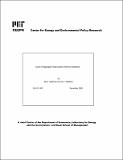| dc.contributor.author | Adelman, Morris Albert | en_US |
| dc.contributor.author | Watkins, G. C. | en_US |
| dc.contributor.other | Massachusetts Institute of Technology. Center for Energy and Environmental Policy Research. | en_US |
| dc.date.accessioned | 2009-04-03T17:05:16Z | |
| dc.date.available | 2009-04-03T17:05:16Z | |
| dc.date.issued | 2002 | en_US |
| dc.identifier | 2002-011 | en_US |
| dc.identifier.uri | http://hdl.handle.net/1721.1/44992 | |
| dc.description.abstract | In what follows, we highlight problems created by aggregation using fixed conversion coefficients (Section 1). We then offer an economic index approach as an alternative, one that recognizes changing relative values of oil and gas over time (Section 2). This aggregation technique - the Divisia index - is applied to US reserve and in situ price data from 1982 to year 2001 to derive implicit shifts in unit costs of aggregated oil and gas reserve additions; these results are compared with those from the traditional fixed coefficient measures (Section 3). Concluding remarks are in Section 4. | en_US |
| dc.description.sponsorship | Supported by the MIT Center for Energy and Environmental Policy Research. | en_US |
| dc.format.extent | 22 p | en_US |
| dc.publisher | MIT Center for Energy and Environmental Policy Research | en_US |
| dc.relation.ispartofseries | MIT-CEEPR (Series) ; 02-011WP. | en_US |
| dc.title | Costs of aggregate hydrocarbon reserve additions | en_US |
| dc.type | Working Paper | en_US |
| dc.identifier.oclc | 52313246 | en_US |
